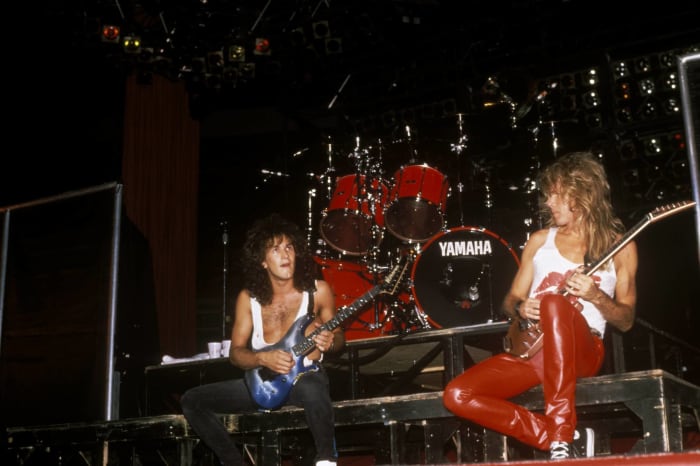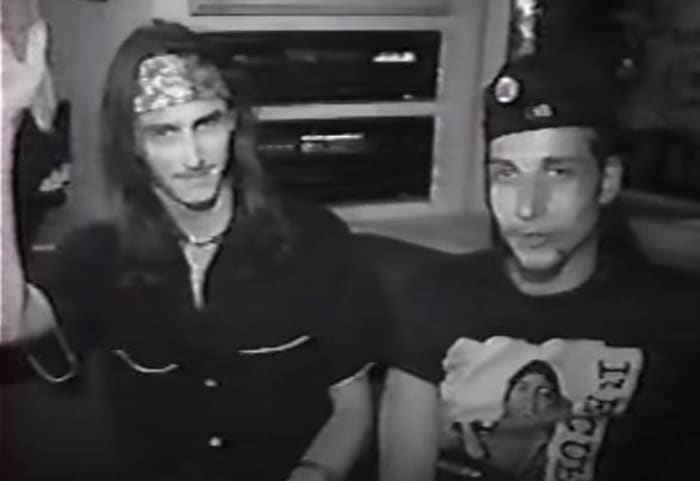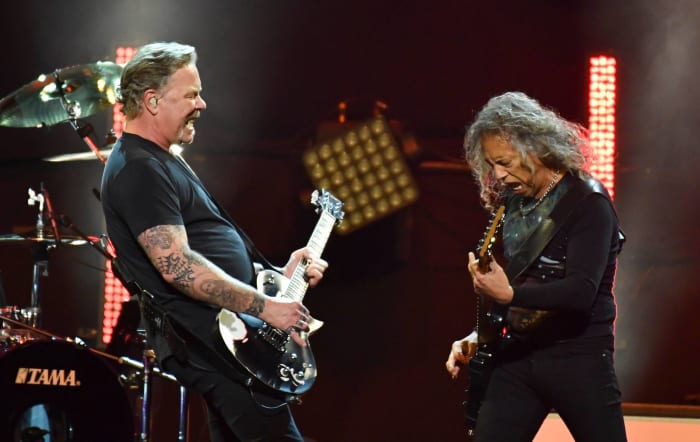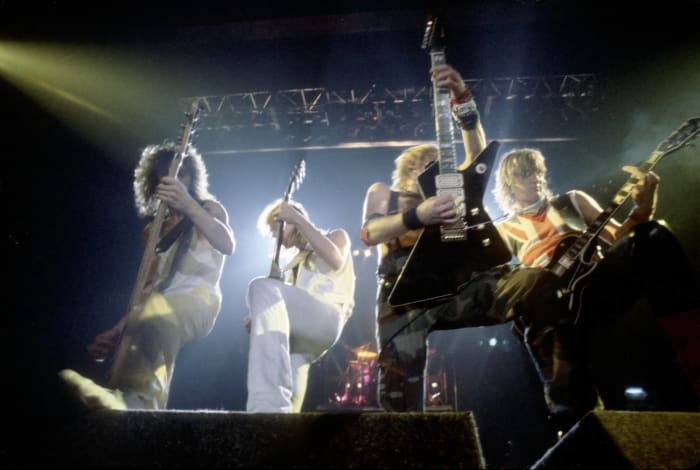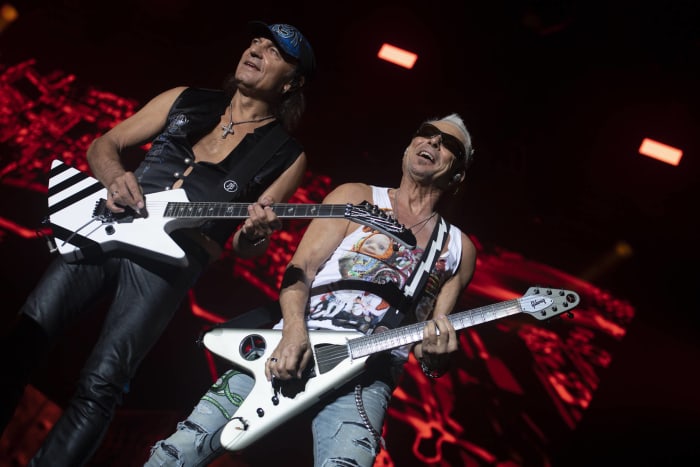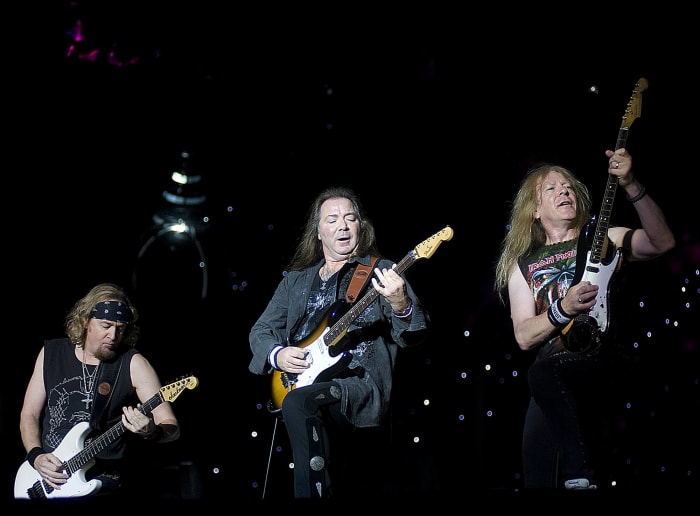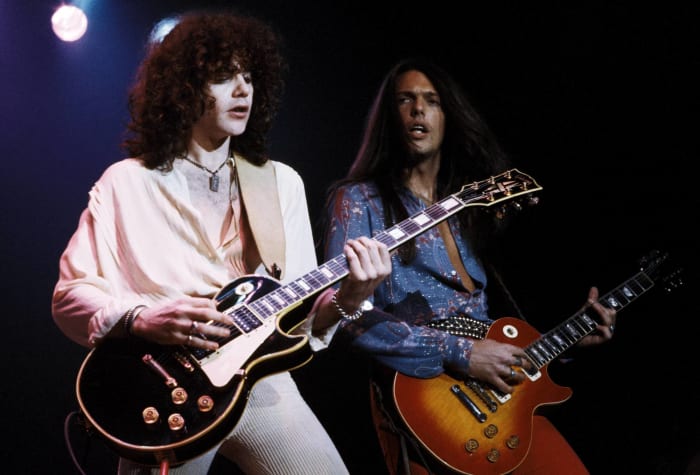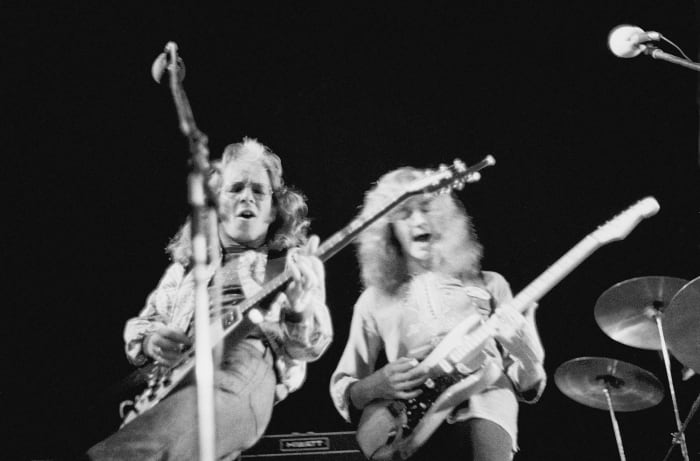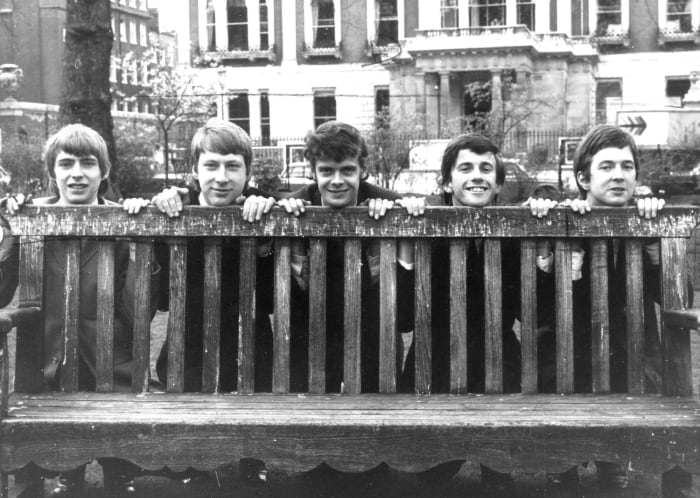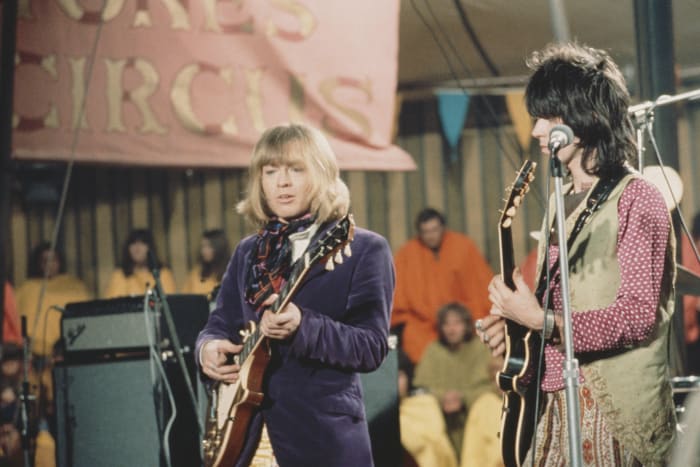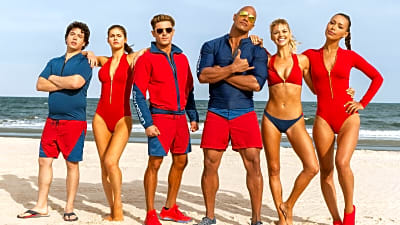There are many legendary one-guitar bands (Van Halen, The Who, and Rush, for example), but sometimes, two or even three guitars are better than one. Some of rock's most legendary bands featured more than one elite guitarist. Here is our ranking of the 25 best.
Anna Krajec/Michael Ochs Archives/Getty Images
The Australian alternative rockers might not be on the radars of today's younger guitar fans, but the band fit in well with the post-punk crowd of the early 1980s and had a psychedelic feel to its sound. The Los Angeles Times dubbed the sound "dense, shimmering, exquisite guitar pop." That should be considered a compliment, thanks to the guitar work of founding members Peter Koppes and Marty Willson-Piper. That pair would eventually leave the band, and Ian Haug, Ashley Naylor, Jeffrey Cain, and Craig Wilson stepped in over the years.
Andrew Nelles/Tennessean.com via Imagn Content Services, LLC/USA TODAY
While Megadeth has seen its share of guitarists come and go, one constant since the trash-metal giants formed in 1983 has been founder Dave Mustaine. This is his baby, and Mustaine has literally abused his body while blistering the strings and keeping Megadeth among the biggest metal bands in the world. Among his ax-wielding bandmates, the standouts include Chris Poland, Marty Friedman, and Al Pitrelli.
Michael Sears/Milwaukee Journal Sentinel/USA TODAY
YouTube
We're talking about the original/classic lineup here with Chris DeGarmo and Michael Wilton. While Geoff Tate's piercing voice might have been Queensryche's signature, the guitar work of DeGarmo and Wilton, regardless of which one was playing lead or rhythm, tended to push the sound forward when the two shared the same stage. They're also responsible for writing some of the band's biggest hits, such as "Eyes of a Stranger" and "Empire."
Ebet Roberts/Redferns/Getty Images
Here are just some who have been part of Whitesnake's traditional yet revolving door of double-attack guitarists. Bernie Marsden and Micky Moody during those early years, then John Sykes for the Slide It In and Whitesnake sessions. Adrian Vandenberg (soloed on the revived "Here I Go Again"), Vivian Campbell, and Steve Vai joined the fun in the late '80s. Most recently, Doug Aldrich, Reb Beach, and Joel Hoekstra have joined leader David Coverdale on the roster.
YouTube
Mike McCready and Stone Gossard are far from the flashiest guitarists on this list. Yet, the duo probably deserves more credit than it has gotten over the years for cementing Pearl Jam as one of the great bands in rock history. While McCready pretty much handles all the lead work, Gossard is an above-average rhythm player who is not out of his element when taking on a solo. Gossard, of course, is responsible for writing the music to some of Pearl Jam's biggest hits, such as "Alive," "Even Flow," "Black," and "Daughter."
YouTube
The furious, aggressive double assault of Kerry King and Jeff Hanneman can best be described as relentless. If there is such a thing as a musical brawl, the Slayer sound was it. And King and Hanneman were a big reason for that. "Seasons of the Abyss," from the 1990 album by the same name, is a perfect example of King and Hanneman each showing off their talent at the next level. Not to be overlooked, Exodus' Gary Holt admirably stepped in in the early 2010s for Hanneman and became a full-time band member upon Hanneman's death in May 2013.
Robert Hanashiro/USA TODAY
In most metal circles, Metallica frontman James Hetfield is considered the best rhythm guitarist in the genre. On the flip side, lead Kirk Hammett might be one of the most underrated guitarists in hard rock/metal history. The latter, perhaps, is because Hetfield and drummer Lars Ulrich command such attention as the leading writers and composers of the band's songs. That said, both Hammett and Hetfield shine on such Metallica classics as "Creeping Death," "Master of Puppets," "Battery," and "One."
Michael Ochs / Getty Image
It started with Steve Clark and Pete Willis, sharing leads while being fine rhythm guitarists. Following Willis' ouster during the Pyromania sessions, Phil Collen stepped in to take over the lead work and help the band become international superstars upon that album's release and the massively successful Hysteria (1987). Following Clark's death in 1991, hard rock veteran Vivian Campbell joined and remains with the group.
Katja Ogrin/Redferns/Getty Images
It's still amazing to think about the guitar talent that's been part of the Scorpions over the decades. The tandem of lead Matthias Jabs and rhythm guitarist Rudolf Schenker is among the best in hard rock and heavy metal (give a listen to "Rock You Like a Hurricane"). But there was also a time when Rudy's brother Michael was part of the band. Not to mention, the great Uli Jon Roth was involved in the group's early days.
11 of 25
15. Tom Petty and the Heartbreakers
YouTube
C Flanigan/WireImage/Getty Images
Joe Perry should go down as one of rock's great lead guitarists. However, his rhythm and co-lead Brad Whitford rarely seem to get the credit he deserves. While Whitford doesn't draw much attention to himself, he wrote Aerosmith's 1976 hit "Last Child," on which he also plays lead. His other prominent solo work can be found on such tracks as "Back In the Saddle," "You See Me Crying," and "Train Kept A-Rollin."
Thos Robinson/Getty Images for Fender
One of the early giants of alternative rock, Sonic Youth housed two of the most widely respected and influential guitarists ever in Thurston Moore and Lee Ranaldo. Later, the versatility of Kim Gordon and Jim O'Rourke kept the band's quality sky high. Sonic Youth was experimental with its overall sound, especially when it came to unique guitar tunings or Scordatura.
14 of 25
12.The Allman Brothers Band
Michael Ochs Archives/Getty Images
For over two years, from 1969 to 1971, Duane Allman and Dickey Betts formed what is still considered one of rock's all-time guitar duos. Betts' lead work and Allman's versatility, especially on the slide guitar, made for a special combination. Allman, who died from a motorcycle crash in October 1971, also played on Layla and Other Assorted Love Songs by Derek and the Dominos. Over the years, Betts was joined by some immensely talented guitarists like Dan Toler, Warren Haynes, and Derek Trucks.
15 of 25
11. The Velvet Underground
Michael Ochs Archives/Getty Images
Sonic Youth was one of the many bands influenced by the avant-garde musical brilliance of The Velvet Underground. But while Lou Reed's knack for an almost psychedelic-sounding distortion and love of feedback, fellow guitarist and original member Sterling Morrison perhaps never got the credit he deserved. Especially when it comes to the late Morrison's lead work, most notably on "Pale Blue Eyes" from the band's 1969 self-titled effort.
16 of 25
10. Fleetwood Mac
YouTube
The evolution of Fleetwood Mac is one that casual rock fans should truly dig into to learn just how different it sounded from the beginning to the present day. Before Lindsey Buckingham, an elite guitarist in his own right, and Stevie Nicks joined the band in the mid-1970s, Fleetwood Mac was a blues-heavy, guitar-laden group that became overshadowed by its pop success of the mid-to-late '70s sound. Peter Green was one of the great blues-rock guitarists of the 1960s and into the 1970s. Jimmy Spencer, Danny Kirwan, Bob Welch, and Bob Weston also held their own as later members of the band. Currently, the aforementioned Mike Campbell and former Crowded House member Neil Finn are in the fold.
YouTube
The list of guitarists the Eagles have employed over the decades is remarkable. It started with Glenn Frey and Bernie Leadon. Then, Don Felder joined for the On the Border (1974) album, and Joe Walsh replaced Leadon when Hotel California (1976) turned the band into one of the most successful rock acts of a generation. As time went on, through reunions and various tours, other heavyweights like Vince Gill were part of the group.
Martyn Goodacre/Getty Images
When we talk about guitar duos, brothers Angus and Malcolm Young must be high in the conversation. While animated lead guitarist Angus was the more visible with his school-boy uniform and on-stage antics, the late Malcolm pretty much ran the band behind the scenes and helped write some of rock's most memorable riffs from songs such as "It's a Long Way to the Top (If You Wanna Rock 'n' Roll)," "Highway to Hell," "Back in Black," "You Shook Me All Night Long," and "Thunderstruck."
19 of 25
7. Lynyrd Skynyrd
Leonard M. DeLessio/Corbis via Getty Images
The triple-lead-guitar attack was a signature of the Skynyrd sound and still is as the band continues to tour. Gary Rossington has been the one constant, while Allen Collins played on the first five records before the tragic plane crash that killed vocalist Ronnie Van Zandt and lead guitarist Steve Gaines, who played on 1977's Street Survivors. Ed King, who wrote the famous riff from "Sweet Home Alabama," played on the group's first three albums and returned for a time when it re-formed in the early 1990s. "Free Bird" live remains the best example of the group's stellar three-guitar sound.
Kevin Nixon/Classic Rock Magazine/Future Publishing via Getty Images
Adrian Smith didn't team up with exceptional lead guitarist Dave Murray until Maiden's second album, Killers (1981). From there, the two blistered their way through some of metal's greatest and most influential albums like The Number of the Beast (1982), Piece of Mind (1983), and Powerslave (1984). When Smith left in the early 1990s, Janick Gers stepped in and remained part of the metal giants when Smith returned later that decade. Murray, Smith, and Gers remain a potent, three-guitar attack to this day.
Fin Costello/Redferns/Getty Images
Thin Lizzy has hosted a bevy of guitarists since its inception in late 1969. Bassist and lead vocalist Phil Lynott was always the band's focus, but it didn't get much better than the double-lead combination of Scott Gorham and Brian Robertson. That pair appeared on two of the band's most successful and recognizable albums, Fighting (1975) and Jailbreak (1976). The latter features classics "The Boys Are Back in Town," "Cowboy Song," and the title cut. In later years, other guitar greats Gary Moore and John Sykes were part of the group.
Fin Costello/Redferns/Getty Images
The casual rock fan of certain age groups probably doesn't know much about Wishbone Ash, the British rockers who had their moment in the early-to-mid 1970s. But thanks to the guitar work of Andy Powell and Ted Turner, the group proved to be a major influence on the likes of Iron Maiden, Van Halen, and Metallica — groups that would enjoy much more commercial success than Ash ever achieved. It's the guitar harmonies that set the band apart from its contemporaries and helped further open the door for more two-guitar bands to take their shot.
24 of 25
2. The Yardbirds
Michael Ochs Archives/Getty Images
Though guitar legends Eric Clapton, Jeff Beck, and Jimmy Page all were members of the Yardbirds, the three never played together with the band during its heyday. Still, any group that could roll out any of these all-time legends, along with the underrated rhythm guitarist Chris Dreja has to be on this list.
25 of 25
1. The Rolling Stones
Mark and Colleen Hayward/Redferns/Getty Images
The conversation with the Stones begins and ends with the legendary Keith Richards. However, co-founding member Brian Jones was as versatile as they come, playing lead and rhythm guitar, sitar and dulcimer. Following Jones' death in 1969, Mick Taylor was more than serviceable while playing on classic Stones albums like Let It Bleed (1969), Sticky Fingers (1971), Exile on Main St. (1972), and Goats Head Soup (1973). Then in 1975 came Ronnie Wood, who already was a star, having played with the Faces and Jeff Beck Group.
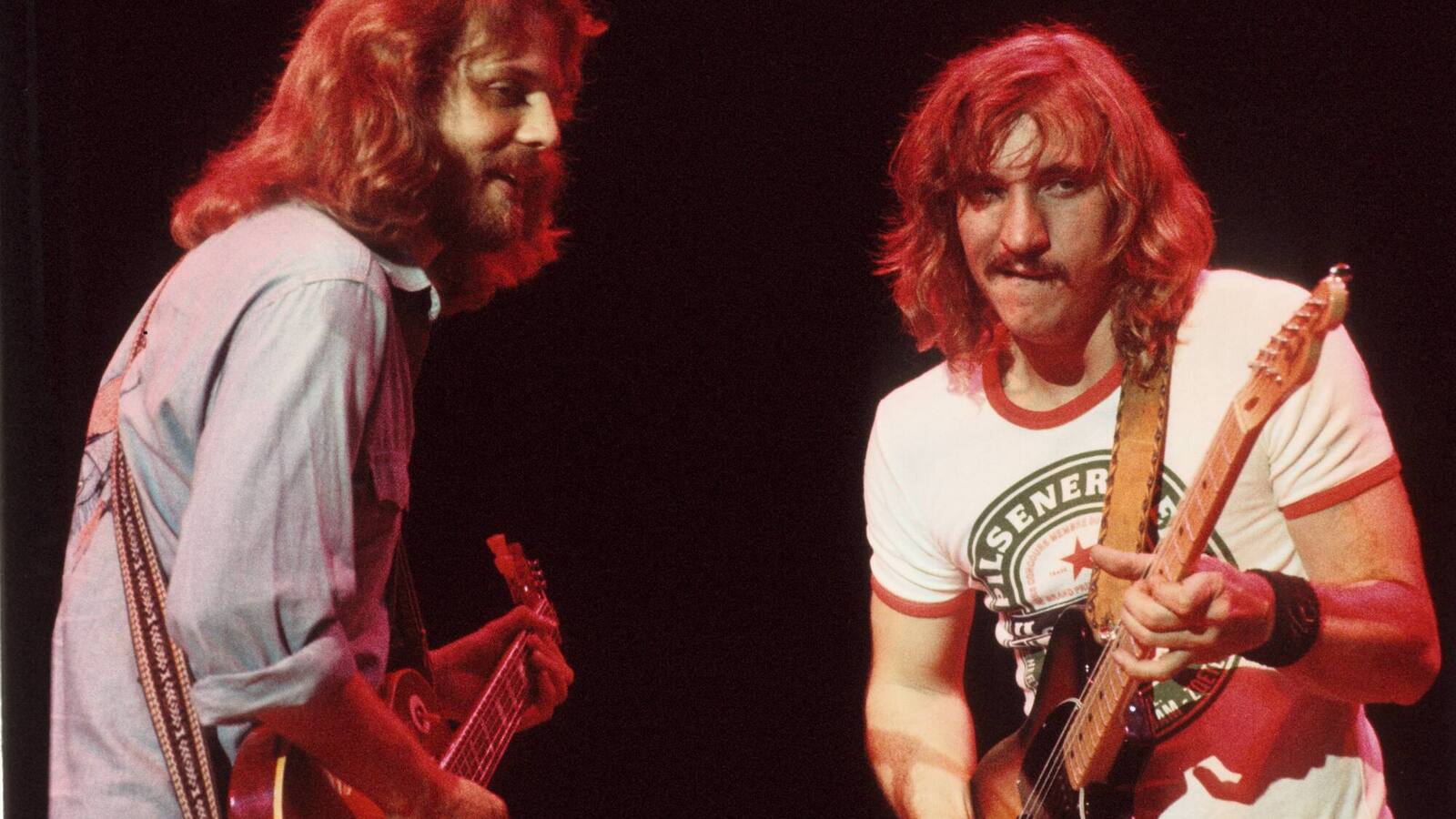
 +
+




